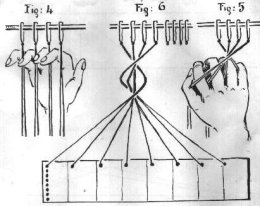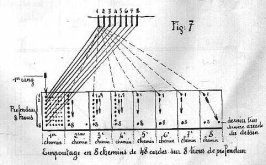- Home
- Resurrection ▾
-
Learn ▾
- Free library
- Glossary
- Documents
- Initiation
-
Shaped fabrics
- Introduction
- Popularization
- Definitions
- Le métier de façonné
- Principes du façonné
- Mécaniques de façonné
- Le jeu des crochets
- Les cartons
- Chaîne des cartons
- Mécanique 104 en détail
- Pour en finir
- Montage façonné
- Empoutage 1/3
- Empoutage 2/3
- Empoutage 3/3
- Punching, hanging and dip
- Autres façonnés
- Façonnés et Islam
-
Cours de tissage 1912
- Bâti d'un métier
- Le rouleau arrière
- Les bascules
- Formation du pas
- Position de organes
- Mécanique 104 Jacquard
- Fonctionnement 104
- Lisage des cartons
- Le battant du métier
- Le régulateur
- Réduction et régulateur
- Mise au métier d'une chaîne
- Mise en route du métier
- Navettes à soie
- Battage
- Ourdissage mécanique
- Préparation chaînes et trames
- Equipment ▾
- Chronicles ▾
- Fabrics ▾
- Techniques ▾
- Culture ▾
- Language ▾

Cording (2/3)

Cording (2/3)
As we have seen above, the purpose of the knotting is to guide the arcades in their movement and to distribute the stitches and wires in the imposed width.
This operation consists in passing the arcades through the holes of the arcade boards, which are held horizontally, while the arcades, which are always double, have passed through their loops on a rope (fig.
Fig.1
Since the width of a fabric is variable, and thus the number of wires and arches more or less high, the number of knotting rows as well as the number of holes forming a knotting row may be greater or smaller . The row begins behind and ends up in front of the hoeing board.
Example of Fig.1: The row has 8 holes deep.
There are commercially available boards of various reductions.
When the assembly comprises more than two paths (ie two repetitions of the pattern in the width of the fabric), the arches intended for the same collar are grouped by a torsion (FIGS. 4, 5, 6).
Fig.4, 5, 6
The statement of a stamping includes:
The number of paths (repeating the pattern in the width of the fabric) and the total width.The number of ropes (= arcades) per pathThe number of holes in depthThe reduction of the planchetteThe place of the first arch (top left or bottom right).

Empoutage (2/3)
As we have seen above, the purpose of the knotting is to guide the arcades in their movement and to distribute the stitches and wires in the imposed width.
This operation consists in passing the arcades through the holes of the arcade boards, which are held horizontally, while the arcades, which are always double, have passed through their loops on a rope (fig.
Fig.1
Since the width of a fabric is variable, and thus the number of wires and arches more or less high, the number of knotting rows as well as the number of holes forming a knotting row may be greater or smaller . The row begins behind and ends up in front of the hoeing board.
Example of Fig.1: The row has 8 holes deep.
There are commercially available boards of various reductions.
When the assembly comprises more than two paths (ie two repetitions of the pattern in the width of the fabric), the arches intended for the same collar are grouped by a torsion (FIGS. 4, 5, 6).
Fig.4, 5, 6
The statement of a stamping includes:
The number of paths (repeating the pattern in the width of the fabric) and the total width.The number of ropes (= arcades) per pathThe number of holes in depthThe reduction of the planchetteThe place of the first arch (top left or bottom right).
Empoutage (2/3)
As we have seen above, the purpose of the knotting is to guide the arcades in their movement and to distribute the stitches and wires in the imposed width.
This operation consists in passing the arcades through the holes of the arcade boards, which are held horizontally, while the arcades, which are always double, have passed through their loops on a rope (fig.
Fig.1
Since the width of a fabric is variable, and thus the number of wires and arches more or less high, the number of knotting rows as well as the number of holes forming a knotting row may be greater or smaller . The row begins behind and ends up in front of the hoeing board.
Example of Fig.1: The row has 8 holes deep.
There are commercially available boards of various reductions.
When the assembly comprises more than two paths (ie two repetitions of the pattern in the width of the fabric), the arches intended for the same collar are grouped by a torsion (FIGS. 4, 5, 6).
Fig.4, 5, 6
The statement of a stamping includes:
The number of paths (repeating the pattern in the width of the fabric) and the total width.The number of ropes (= arcades) per pathThe number of holes in depthThe reduction of the planchetteThe place of the first arch (top left or bottom right).